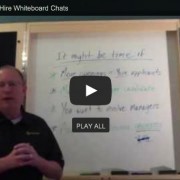Managing Time Off Requests
Kids are not the only people who count the days to summer vacation…adults have their own countdown as well. June, July, and August, in addition to December due to its many holidays, are the months when employees request time off more than any other time of the year. Federal holidays that might yield a day off here and there simply might not be enough of a break from work. By mid-year, employees can feel in a “rut” and need an extended break from the work environment. Research shows that employees who use their vacation time are more productive. Employers who support their employees’ use of vacation time have higher employee engagement and retention rates. With careful planning and effective communication of policies and procedures, employers can successfully balance summer vacation requests without impeding productivity.
Paid Time Off Policy
To alleviate any confusion on how vacations can be taken, a clearly defined paid time off (PTO) policy needs to be in place and communicated with all employees. When creating a PTO policy, include specific information about vacations at peak times such as summer months and December. Often employees with children want to take time off together for travel during summer. Their children are out of school resulting in an influx of PTO requests during these peak times. Eloquently, but succinctly, describe the guidelines, parameters and expectation of paid time off for employees. PTO policies must be clearly defined and address these factors:
- PTO accrual: How is PTO accrued? Is there a general bank of time that is used for both vacation and illness, or are there a certain amount of hours or days allocated for illness only and personal matters (travel, appointments, etc.) only? How can employees check their amount of PTO time?
- PTO allocation: Is there a maximum time of PTO that can be used in one duration? Is there a minimum amount of notice needed for PTO requests? Are there specific months that employees cannot take PTO? While most companies offer PTO as a benefit, employers are discouraged from prohibiting employees from taking PTO during certain months. However, if there are no state or local paid leave laws prohibiting it, employers can restrict employees from taking PTO during certain time frames if the employees’ absence would cause undue hardship on the company. (FMLA would not fall into this caveat.) Word of caution: employers who offer PTO but have strict limits on when and how it can be used tend to have more employee turnover.
- PTO request: Is there a limit of PTO requests per month? How do employees request PTO? Does the request get submitted to the direct manager only, or are there any other people or departments (i.e. Human Resources, area manager(s), etc.) who should be included also? How can PTO requests be canceled if needed? Is there an online or paper form to submit, or is it emailed to designated employee(s)? Be cautious of paper. Not only is it environmentally unfriendly or cost ineffective, but if a paper PTO request gets lost, it will wreak havoc on scheduling.
Time Off Reminders
Vacation policies must be communicated at the time of new employee orientation and acknowledgement can be documented in the company’s employee onboarding software. Policies and reminders to use PTO should be communicated frequently by managers and HR to employees. Ensure policies for time off are clearly defined and understood by all employees to mitigate the potential for denied PTO requests. Having a clearly defined PTO use policy helps prevent the company from being short-staffed in peak times. Policies must be consistently enforced in all locations of the company.
Time Off Planning
Consider starting a new year campaign in January to encourage employees to plan and schedule their vacation time for the year. Post-holiday blues can impact productivity and motivation. Encourage employees to plan ahead for their future “fun times” early in the year which helps managers begin to plan for staff absences and task delegation. During peak PTO times, teams must be aware of their members’ PTO absences. Have a sign or a board to create a visual reminder of who is out of the office and when they are slated to return.
Include out-of-office updates on the team’s shared calendar to help employees plan accordingly to prevent overlapping PTO requests by teammates. If overlapping PTO requests occur, management should refer to the PTO policy when granting or denying time off. Some policies will include parameters on the number of employees out-of-office at one time. While other policies might be more lenient depending on the workload and if it is a busier time internally. Company policies should include “tiebreaker” criteria. Does seniority of the employee matter? Is it based on who submitted the PTO request first? How much time off have the employees already taken? We should not take out the human in Human Resources so it is important to consider the personal motivators driving the PTO request as well.
Communication
Prior to going out-of-the office, the employee should communicate with their team and/or manager about the status of key items. Are due projects completed? Are there any items that are pending or awaiting outside or internal communication that should be addressed? Teammates often pick up the out-of-office employee’s duties while they are out. Provide cross training on tasks early so employees who are in the office do not have a learning curve. This can limit bad performance in the out of office person’s tasks in addition to their own.
Consider incentives for those employees who want extra hours. Or those who step up to cover responsibilities for teammates who are out of office. When multiple employees within a team or unit are out at the same time, know what the parameters are for contacting them in case of emergency. Incorporate efforts to reduce the tasks and projects employees must complete immediately upon return.
Encourage all employees to use allocated vacation time. Time off is meant to be a way to reduce stress and prevent burnout. While vacations are meant to be relaxing and refreshing, the thought of “all the work” that an employee must catch up on upon their return often leads to people not wanting to use vacation time leading to burnout and frustration. Let the employee come back and stay refreshed back at work after time away. That is the purpose of PTO – time off. When companies encourage the use of PTO, it communicates a vested interest in the physical and mental wellbeing of its employees making the company more desirable to current and prospective talent. It is a win-win for all!
Conclusion
If your HR team needs support with hiring during these summer months or throughout the year, learn more about ExactHire’s Full Service Hiring.








